I have been undergoing an identity excavation and restructuring for the last couple of years. This excavation became somewhat archeological in 2010 when I traced my genealogy and ancestors. Who are they and then who does that make me? I have been trying to measure all of the genetic material and what it has overcome […]

Along the journey...
I have been undergoing an identity excavation and restructuring for the last couple of years. This excavation became somewhat archeological in 2010 when I traced my genealogy and ancestors. Who are they and then who does that make me? I have been trying to measure all of the genetic material and what it has overcome to endure and thrust me forth. I guess I was looking for perspective, but the question quickly turned into “what did they eat?”
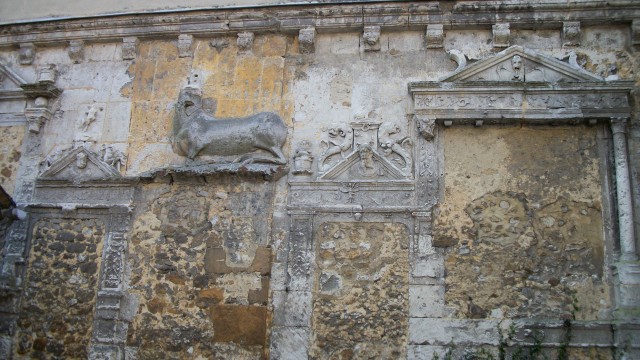
Where the search for my roots would take me
For Christmas 2010, I went on an extreme back-country ski trip in the Charlevoix region, being prepared for cross-country skiing with a friend from Montréal and two great girlfriends from France. We had a great time, without accomplishing the skiing from refuge to refuge. We ate a decadent reveillon dinner in a cabin in the woods and then got shamanistic and loose in an igloo under the moon. On the way home, though, we stopped in the villages of my ancestors: Petite-Rivière-St-François for my Simard side, Chateau Richer for my Chabot and Mésange side and Ste-Anne-de-la-Pérade for my Leduc side. It was winter and very beautiful, but things were closed for the holidays, and the only hint of my ancestors’ diets was that in Ste-Anne-de-la-Pérade were the ice fishing cabins dotting the river, and I imagined my ancestor Antoine Leduc, courreur des bois, ice fishing as well. These cute villages seemed to take on a special meaning as I connected them to my genetic origins.
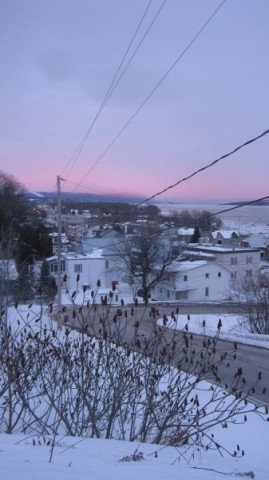
The sun going down on the idyllic Chateau Richer, Qc., once the home of my Chabot and Mésange sides
In the summer of 2011, I went to France to visit the same French girls I had visited my ancestral villages with in Québec. I wanted to see them all, but I didn’t have time to see Angoulême where my Simard side is from. I did see Nalliers in Poitou-Charentes where my father’s paternal Chabot side emigrated from. It was really old, rural and quiet. The village was tiny, the church empty and I only saw a few really old people in the streets.
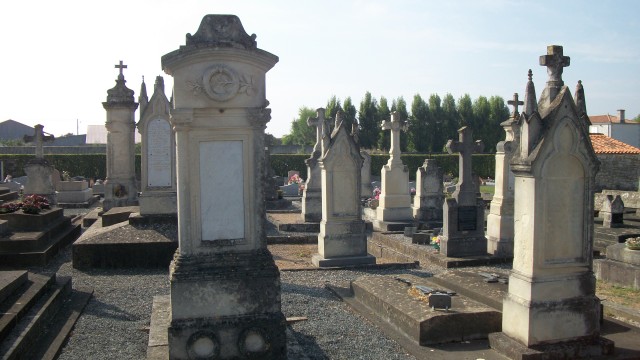
Generations upon generations in Nalliers in Poitou-Charentes' cemetary- origin of the Chabot family
The second place I visited was the origin of Antoine Leduc, my maternal grand-mother’s ancestor. There is a novel about him and he had quite the adventures as a Courreur des Bois, getting married to a Fille du Roi and eventually getting killed in the Toronto or Detroit region by the Iroquois while trading furs. His village was called Louvetôt and it was in Normandy.
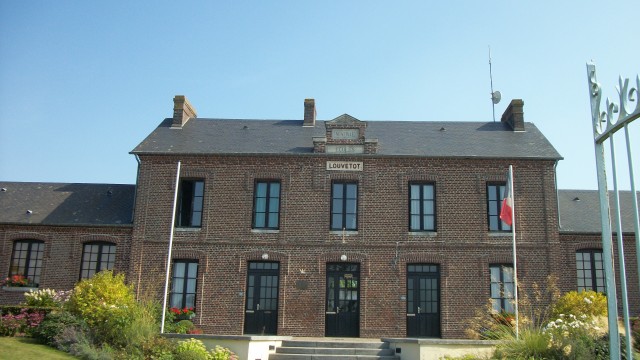
School and town hall in the village of Louvetôt in Normandy- origin of Antoine Leduc the Courreur des bois
I took the train from Rouen to the closest village and then I was going to walk 7 km to Louvetôt. A trucker picked me up, and asked why I was going to Louvetôt as I was obviously far from home. I told him I was searching my ancestral lands for my roots. He said “Oh la vache!” when he thought about someone coming from Canada to a place like Louvetôt with probably about 100 inhabitants.
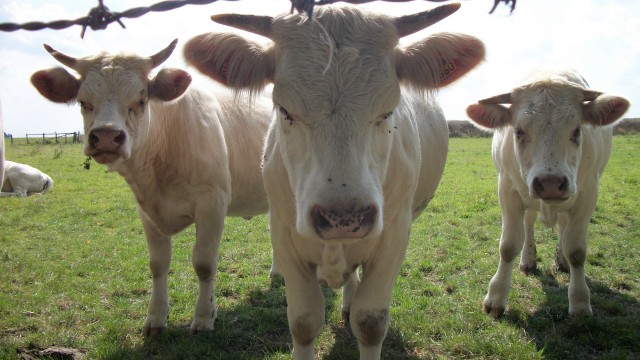
Oh la vache! La sacrée vache! The cow, like the apple, is for real in Normandy!
When I got there, I couldn’t really figure out what they ate either as they had one bakery that sold a few pan-French pastries and cheap candy. There was a church and the City Hall and school were combined. It took me about 5 minutes to walk from one end of town to the other. I walked through the countryside all afternoon from one rural village to the other. It was nice, but I didn’t find my ancestors’ food.
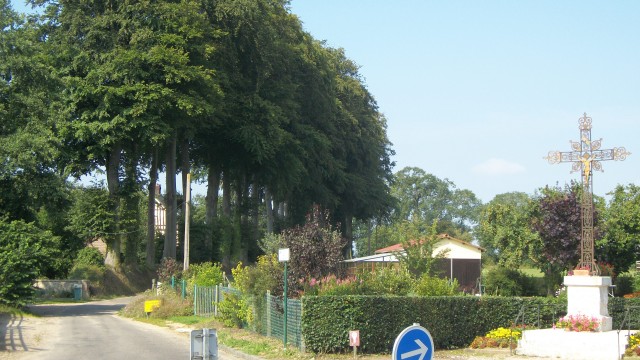
Cross and all- Louvetôt
The last place I visited though was wonderful! It was called Mortagne-Au-Perche- still in Normandy. I hitch-hiked there and was driven by a sweet Portuguese family and a very kind Turkish man that went out of his way to bring me there. I stayed with a sweet 71 year-old woman named Madeleine.
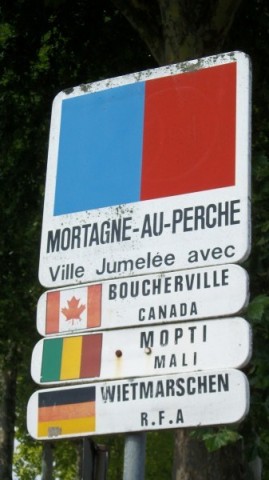
Mortagne-au-perche sister city with Boucherville- really?
Mortange was the place of origin of my ancestor Marie Mésange, wife of Mathurin Chabot(My father’s paternal ancestor). She was baptized on April 4th, my birthday, and Mathurin died on June 12th the day of my father’s birth. Mésange is the French name for the tit (bird).
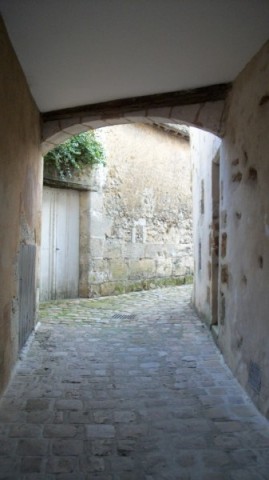
What will one find when one looks inside?
The culinary past is still present. Boudin Noir! Mortagne is the capital of Boudin Noir (black blood sausage or pudding). Over 100 exhibitors, butchers, traders and artisans from around the world gather for an annual festival for blood sausage enthusiasts! Four to 5 kilometres of black blood sausage is sold during the three days. There is a competition for who has the best blood sausage (tasted cold), a pig squealing contest and participants have to take a vow, swearing that they eat blood sausage at least once a week religiously and that they will sing and spread the good news.
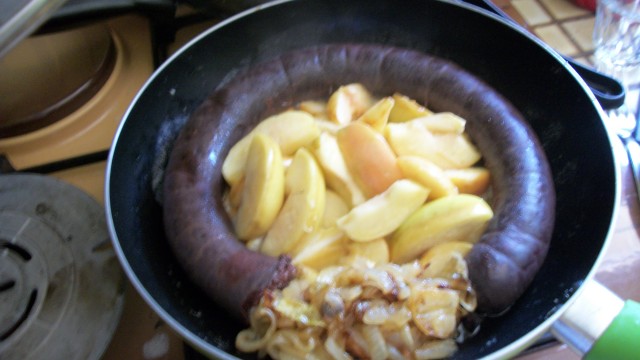
The real comfort food that resonates in my dna! Blood sausage, apples and onions.
I didn’t eat blood sausage until I got to Québec, and I loved it. It felt like coming home. I made it for my Simard family in a Caribbean-style (Pudding and Souse) a few years ago. My Mom, my Aunts and Grand-parents were overjoyed to eat boudin visibly displaying pangs of nostalgia, but my cousins weren’t having it. Why did blood sausage feel comforting and delicious to me and not my cousins?
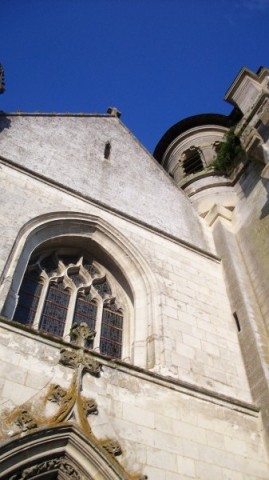
The Church

My heart skips a beat!
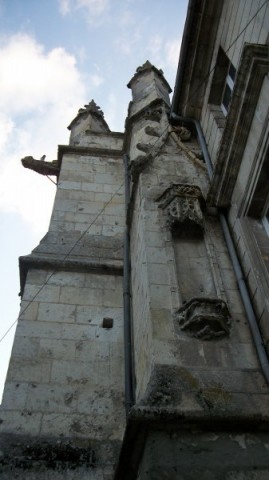
Pangs of nostalgia- so beautiful
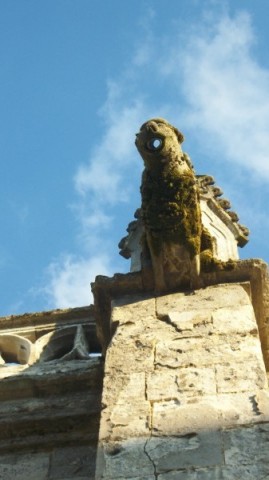
Gargoyle avec un peu de vécu et de la vie
I really felt at home in Mortagne-au-Perche. The architecture and scenery was gorgeous. I was welcomed into Madeleine’s home. I also enjoyed the company of Madeleine’s friends one evening, two newly re-married couples in their 60’s living life to the fullest, cracking jokes, the wine flowing, getting that dreamy Shangri-la look when they spoke of the mystical Quebec of Gilles Vigneault that they’d never gotten a chance to visit, but had seen on tv so many times.
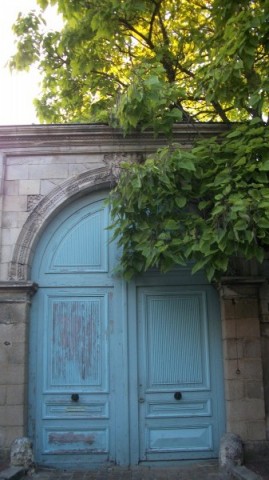
The door
They grumbled about how the butcher, in the centre of town with a snazzy shop, shouldn’t make blood sausage because he’s stealing business and the work of the charcutier. They made it clear that Le Roi du Boudin was the place to go. The boudin was delicious. I had it smoked, with candied oranges, apples, chestnut, and much more. Other regional specialties in Mortagne-au-Perche are cider, pommeau and calvados. I don’t drink anymore..but I drank while I was there… I love pommeau and cider and it was great with the blood sausage. I did find traces of my ancestors: I ate what they ate, I saw buildings that had belonged to the aristocratic Mésange family and I saw the bird itself.
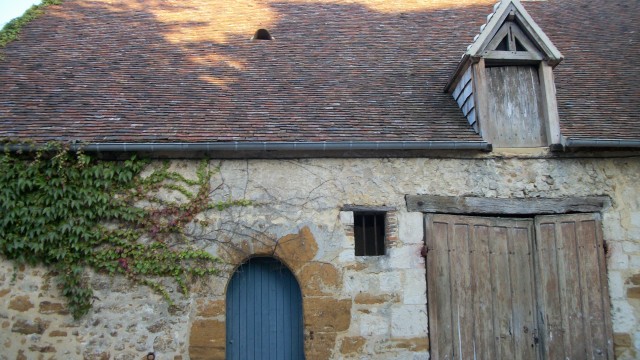
It's good to be home...
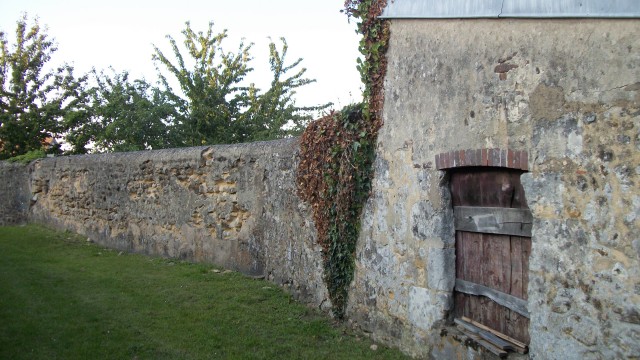
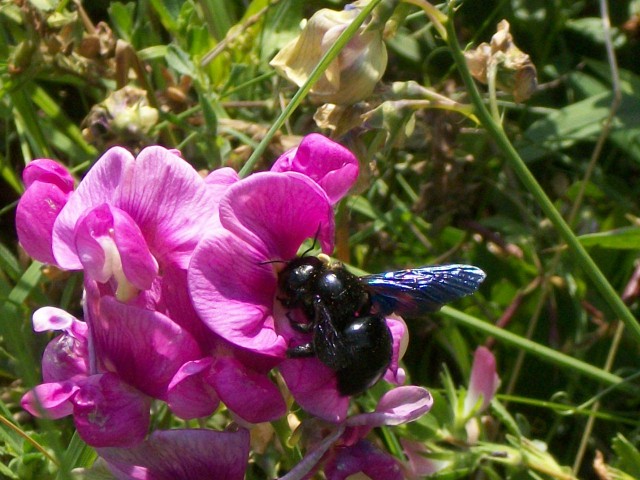
Mélissa means "honeybee" in Greek. The sweet pea is my flower. On the last day of my trip I saw a group of black carpenter bees with blue iridescent wings in a patch of sweet peas. Thank you!
This summer I spent 6 weeks in Europe: France, Germany and England, to be precise. All European countries are experiencing the recession, some more severely than others. In France the lack of work and high cost of living seemed to be the topic of choice, while in London the bars were as full as when […]
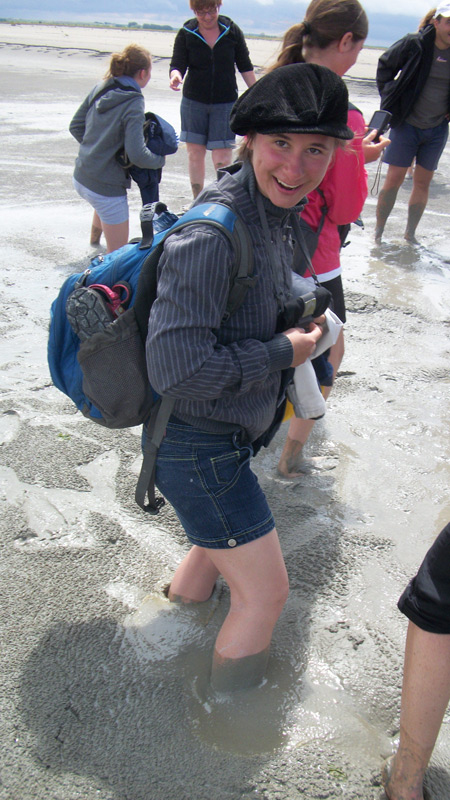
MY FIRST POST
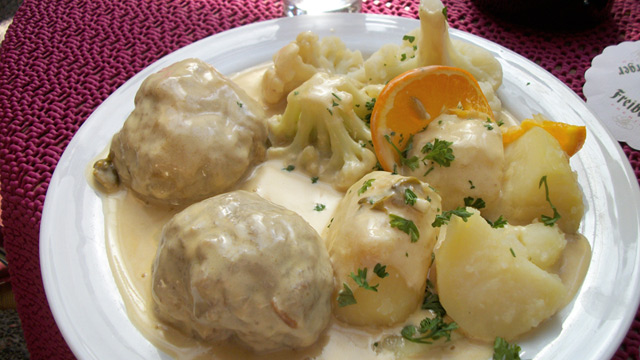
Konigsberger klopse - german meatballs in creamy caper sauce
Regardless of the complexity of the immigration situation in Europe, one clear contribution of immigrants in France, Germany and England is cheap good eats. Turkish, Vietnamese, Thai, Indian, and pseudo- Japanese eateries dot city blocks. For myself, foreign fare tends to have a bit more of my daily vegetable intake than the local fare. The spunkier flavours are also a welcome change for extended European visits (especially in England). No one can take France’s culinary medals from them, but for inexpensive French cuisine, it really is hit and miss. France’s culinary reputation has given them license to rape tourists, on occasion serving them food that is shabby by North American standards. (Tiens!) Yet many French, Italians and Spaniards retain their chauvinistic approach to food. Some know and care only to know local and national food. In what are supposed to be modern transient societies and were the birthplace of colonialism and the mass spread of culture, people and social systems around the world, the frequent lack of interest in other culinary traditions is shocking. When Italians get off the plane in Tunisia and immediately start looking for pizza- this is a problem.
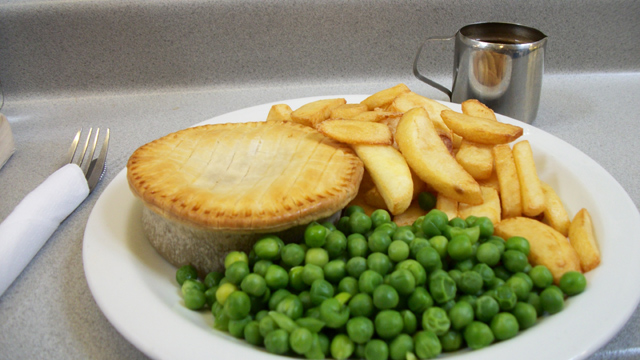
Steak and kidney pie with green peas and chips in London.
Food is very emotional and we connect it to our moms and grandmas and it is key in our cultural identity, whether it be a pure or a melting pot identity. It is normal to be attached to one’s gastronomic traditions, yet I saw a delicious example of where two cultures met on a middle-ground. Resolving cultural differences by planting roots in the here and now in new cultural realities and using food as the medium, well- that’s amazing!
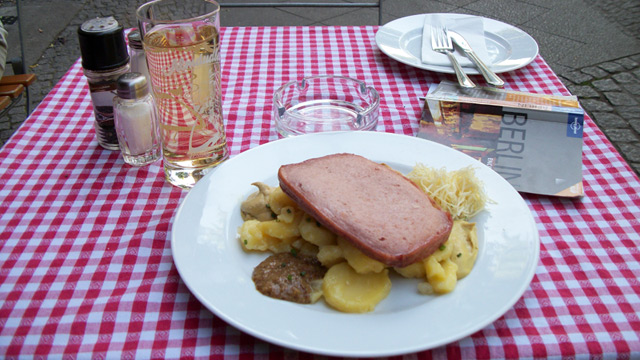
Wiener like sausage loaf with potato salad, fresh horseradish, 3 mustard's and a spritzer.
When I was in Berlin, I had a dream about poaching a duck breast and then slicing it thinly. In my dream I was very anxious about the whole process and how it should be served. Don’t ask me what the dream means, I do not know! The next day, after some fun-filled hours of visiting museums documenting the suffering caused by over-zealous government/army regimes, I stopped in to a roadside Thai/Vietnamese/Chinese shack for a bit of respite from Europe’s heavy history. The establishment was an orange snack trailer with a bamboo fenced in terrace, and a nice calming breeze, just there- or so it seemed! It felt like an oasis in the dessert. All the clients were Germans- original ethnic Germans, no immigrants- first, second or whatever generation- just Germans. One of my favourite things about ordering in a country where you don’t speak the language is ordering a random item off the menu and getting a total surprise. I settled on number 30 Knusprig ente under the section Ente-Gerichte. It was described as follows:abgeschmeckt mit basilicum, zitrongras, kokomilch, gruen, bohnen und rotem curry dazu Duftreis. Okay, I’m not completely ridiculous, I knew there was basil, lemongrass and coconut milk in it. After an eager and short wait, delivered to my table was a schnitzel-style (breaded and fried) piece of meat, sliced thinly laying delicately on a bed of creamy curried vegetables with a little temple of rice next to it. I picked-up one of the pieces of meat with my chopsticks, oggled it and noticed it was somewhat dark,… doesn’t look like pork. I took a bite and the texture was like poultry, but not chicken, much more flavourful…Oh my goodness, I got a breaded fried duck breast with vegetables for 5.50 €! Get out! The duck was a schnitzel-style interpretation of Southeast Asian breaded and fried meat… but it was really good. The curry had this kind of synthetic- Knorrish type of flavour and wasn’t very spicy, but it was also very nice. I looked around and saw the calm of other satisfied customers. Neither German nor South East Asian food is supposed to be like this; some elements were toned-up, while some toned-down but the compromise was really good. The lack of purity did not seem to pose a threat to any of the others eating…why should I care? I remembered my dream and felt this was an answer to my dream-time duck anxiety (I still don’t really know what it means.)
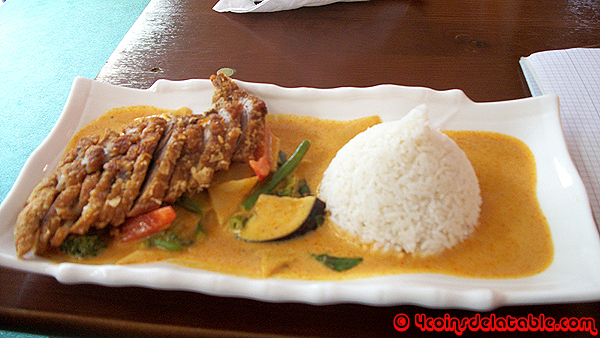
Knusprig ente - crispy duck with curried vegetables and rice
Knusprig ente – crispy duck with curried vegetables and rice
This seemed to be an answer to the intolerance question. For a new-arrival to integrate local traditions into his culinary practice is a great step towards leaving behind one’s past life. This dish was about embracing change and living one’s reality, weaving the best of both worlds together…and for 5.50€ , come on. You take the fried meat you made at home, but then you try it the way the people make it where you are. Do the same with the sauce and serve it back to them. That’s what exchange is! You take your original premise, modify elements of it with ideas you take from another tradition and then give it back to them as a gift. Everyone is happy! The customers were happy… and many. The men working there had a lightness and joy about them and were living it up in the new-life . They all waved eagerly and with pride when they saw me trying to take a photo of their roadside stand on the sly. They were enjoying the best of both worlds. They weren’t sinking with purist rigidity; they were rising above, transcending, transmuting the heaviness of the many close-minded.
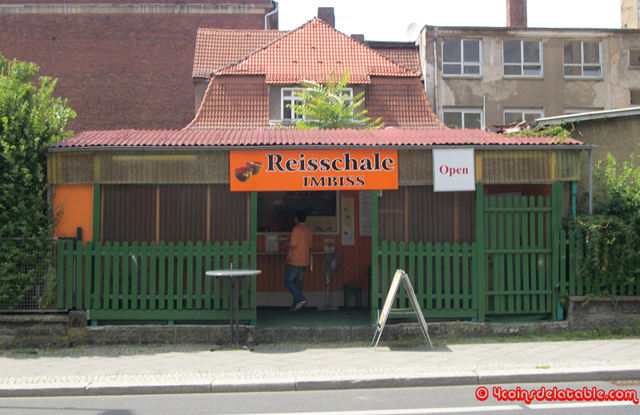
Inbis Reisschale Berlin chain
This dining experience was also unlike the dumpy Chinese restaurants in Montréal that serve a worst of both worlds rendition of Chinese food because they don’t think Canadians ‘can handle it’. It also wasn’t the super-segregated all-Japanese or all-Chinese restaurants in Vancouver where everyone turns and looks at you with gaping-mouth if you cross the invisible border and actually come in to see what’s going on on the other side.
Sampling the gastronomic fare of other cultures and sharing yours with them is a way of ingesting traditions, and the common sensory and nutritional experience of a people. People are proud of their food. When you taste the food of an up-rooted immigrant, you can at least appreciate that they ‘are not from here’. They have their own baggage and know-how, and they try to recreate what they know without having all of the same ingredients. It’s hard to cook up an identity- one that works, one that you feel good about, It’s also hard to mix in new unacquainted ingredients, but usually with trial, error and a little common sense you can make it work with what you have. Kudos to the roadside Buddhas and the high-end foodies around the world that find a way to use food to bridge the gap.
Note
The restaurant is called Imbiss Reisschale and there are different locations around Berlin, but the one I ate at was at 68 Ruschestraße, Berlin.
Little Facts
Knusprige Ente- is what we would call “Crispy Duck” in English. In Chinese cooking, the duck is usually cooked with aromatics and then fried without being breaded. In German cooking Schnitzel is a piece of white meat- veal or pork- that is pounded until thin, coated in bread crumbs and then fried.
Challenge
I challenge you to do you own crispy duck- rubbed and cooked with the aromatics you like- maybe anise, ginger, scallions, garlic and then breaded in the style you like and fried- beer batter, panko, egg, flour and soft bread crumbs- as you wish. What is your reality?
CATEGORIES
Archives
- February 2022 (1)
- October 2020 (2)
- September 2020 (1)
- January 2016 (1)
- January 2015 (1)
- October 2014 (1)
- February 2014 (1)
- January 2014 (1)
- July 2013 (1)
- June 2013 (2)
- May 2013 (1)
- March 2013 (1)
- February 2013 (2)
- November 2012 (1)
- September 2012 (1)
- June 2012 (2)
- May 2012 (1)
- April 2012 (1)
- March 2012 (1)
- February 2012 (1)
- January 2012 (2)
- December 2011 (1)
- November 2011 (4)
- October 2011 (4)
Popular Tags
'Round Table Tours Asian breakfast business prolfiles cabbage canning Community Europe Events farms fermentation Fitz & Follwell Food & Story Food history Food Production food tours fresh juices Friends gastronomy health herbs History Italy kimchi Meal exchange Nuart organic preserves public Quebec restaurant Rumble & Shakes Réseau d`Entraide de Verdun salt smoothies spicy Tours de la Table Vegan youtube videos


